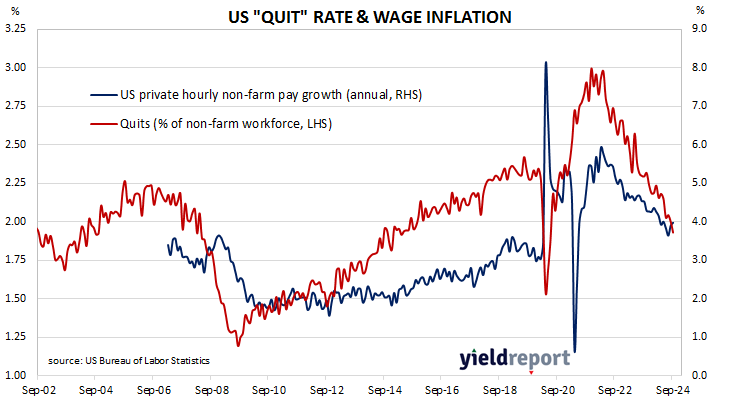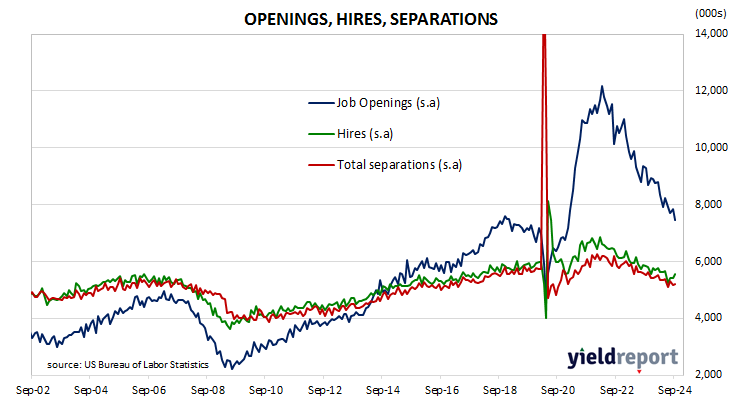Summary: US quit rate ticks down to 1.9% in September; Westpac: figures neither a concern for inflation nor activity growth; US Treasury yields fall; expectations of Fed rate cuts firm, at least four more cuts priced in; fewer quits, fewer openings, more separations; ANZ: Hurricane Helene likely had impact on openings.
The number of US employees who quit their jobs as a percentage of total employment increased slowly but steadily after the GFC. It peaked in March 2019 and then tracked sideways until virus containment measures were introduced in March 2020. The quit rate then plummeted as alternative employment opportunities rapidly dried up. Following the easing of US pandemic restrictions, it proceeded to recover back to its pre-pandemic rate in the third quarter of 2020 and trended higher through 2021 before easing through 2022, 2023 and the first half of 2024.
Figures released as part of the latest Job Openings and Labor Turnover Survey (JOLTS) report show the quit rate ticked lower in September after revisions. 1.9% of the non-farm workforce left their jobs voluntarily, down from August’s upwardly-revised rate of 2.0%. Quits in the month decreased by 107,000 while an additional 254,000 people were employed in non-farm sectors.
“The survey remains consistent with a labour market that is neither a concern for inflation nor activity growth,” said Westpac economist Jameson Coombs.
The report came out at the same time as the latest Conference Board consumer sentiment survey and US Treasury bond yields declined almost-uniformly across the curve on the day. By the close of business, the 2-year Treasury bond yield had lost 3bps to 4.10%, the 10-year yield had shed 2bps to 4.26% while the 30-year yield finished 3bps lower at 4.50%.
In terms of US Fed policy, expectations of a lower federal funds rate in the next 12 months firmed slightly, with at least another four 25bp cuts factored in. At the close of business, contracts implied the effective federal funds rate would average 4.64% in November, 4.50% in December and 4.22% in February. September 2025 contracts implied 3.645%, 118bps less than the current rate.
The fall in total quits was led by 94,000 fewer resignations in the “Professional and business services” sector while the “Retail trade” sector experienced the largest increase, 41,000. Overall, the total number of quits for the month decreased from August’s revised figure of 3.178 million to 3.071 million.
Total vacancies at the end of September plunged by 418,000, or 5.3%, from August’s revised figure of 7.867 million to 7.443 million. The fall was driven by 178,000 fewer open positions in the “Health care and social assistance” sector while the “Finance and insurance” sector experienced 85,000 more offerings, the single largest increase. Overall, 10 out of 18 sectors experienced fewer job openings than in the previous month.
“The decline was led by a 325,000 drop in openings in the South, where it is likely that Hurricane Helene would have had an impact,” said ANZ economist Madeline Dunk. “The job openings to unemployed ratio continued its gradual descent and stood at 1.09 in September.”
Total separations increased by 28,000, or 0.5%, from August’s revised figure of 5.168 million to 5.196 million. The rise was led by the “Retail trade” sector where there were 29,000 more separations while the “Professional and business services” sector experienced 66,000 fewer separations. Separations increased in 10 of the 18 sectors.
The “quit” rate time series produced by the JOLTS report is a leading indicator of US hourly pay. As wages account for around 55% of a product’s or service’s price in the US, wage inflation and overall inflation rates tend to be closely related. Former Federal Reserve chief and current Treasury Secretary Janet Yellen was known to pay close attention to it.



